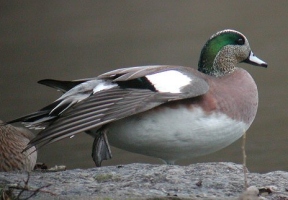|

Medium dabbling duck, brown body with
white crown, large green ear patch extending to back of head, buff
washed breast and sides, and white belly. White shoulder patches visible
in flight. Black-tipped pale blue bill. Swift direct flight, strong
wing beats. Flies in tight flocks.
The male American Wigeon has a white forehead and crown, wide green
ear patch and a white head with heavy black streaking and a pale blue
bill with
a black tip.

|
AMERICAN
WIGEON
Anas americana
ANSERIFORMES
Geese and Ducks (Anatidae)
Range and Habitat
American Wigeon: Breeds from Alaska, northern Manitoba and southern
Quebec south to Nevada, the Dakotas, and the Great Lakes region, rarely
farther east. Spends winters mainly along the Pacific, Atlantic, and
Gulf coasts. Marshes, ponds, and shallow lakes are preferred habitats.
SOUND: "whew, whew, whew"
The American Wigeon was formerly known as "Baldpate" because
the white stripe on their crown resembles a bald man's head. Their short
bill enables them to exert more force at the bill tip than other dabbling
ducks, thus permitting efficient dislodging and plucking of vegetation.
Their diet has a higher proportion of plant matter
than the diet of any other dabbling duck.
A group of ducks has many collective nouns, including a "brace",
"flush", "paddling", "raft", and "team"
of ducks.
The American Wigeon can be found practically all over the world, including
numerous countries in North America and South America. There have also
been sightings of this bird in other countries such as France, Lithuania,
Portugal and many others in the Middle East and Europe. With a range
of more than 7 million kilometers, the American Wigeon currently has
a population of nearly 3 million individual birds.

|